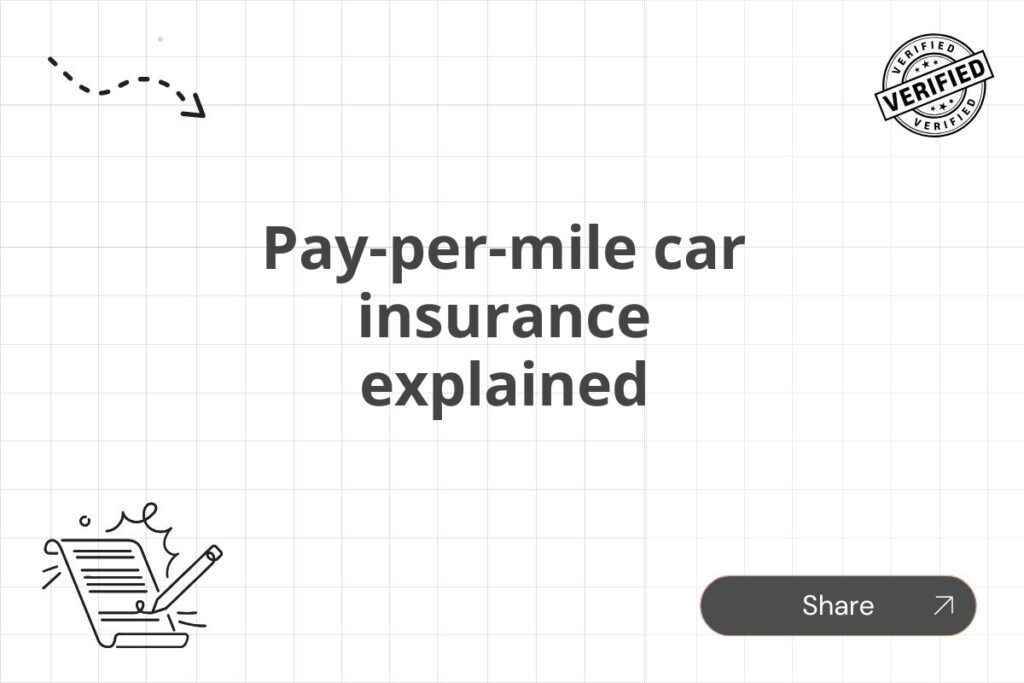Meta Description: Unlock savings with pay-per-mile car insurance! Learn how it works, who it benefits, and if it’s the right choice for you. Compare rates and find the best deal on this innovative insurance option. Get informed and save money today!
Pay-per-mile car insurance, also known as usage-based insurance (UBI), is a revolutionary approach to auto insurance that charges you based on how many miles you drive. Unlike traditional policies with fixed premiums, pay-per-mile insurance adapts to your driving habits, potentially leading to significant savings for low-mileage drivers.
This comprehensive guide will unravel the intricacies of pay-per-mile car insurance, explaining how it works, its advantages and disadvantages, who it benefits most, and how to find the best policy for your needs. We’ll also delve into the technology behind it and address common concerns surrounding this innovative insurance model.
How Pay-Per-Mile Car Insurance Works
The core principle behind pay-per-mile insurance is simple: the less you drive, the less you pay. Instead of a fixed monthly or annual premium, your insurance cost is calculated based on the number of miles you drive during a specified period, typically a month or a year. This is tracked using one of several methods:
- Onboard Telematics Device: Many insurers provide a small device that plugs into your car’s onboard diagnostics (OBD-II) port. This device monitors your mileage, driving habits (speed, acceleration, braking), and even location, transmitting data wirelessly to your insurer.
- Smartphone App: Some insurers utilize smartphone apps to track your mileage. You’ll need to enable location services and allow the app to access your phone’s GPS data. This method is generally less precise than an onboard device.
- Manual Mileage Reporting: In some cases, you may be required to manually report your mileage at the end of each billing period. This method is less accurate and often prone to errors.
Once your mileage is recorded, your insurer calculates your premium based on a base rate plus a per-mile charge. The base rate covers the fixed costs associated with your insurance, while the per-mile charge reflects the variable cost associated with your driving.
Advantages of Pay-Per-Mile Car Insurance
Pay-per-mile insurance offers several compelling advantages, particularly for low-mileage drivers:
- Cost Savings: This is the most significant advantage. If you drive less than the average driver, you’ll likely pay significantly less than with a traditional policy.
- Flexibility: Pay-per-mile insurance is particularly advantageous for those whose driving habits fluctuate throughout the year. For example, if you drive less during winter months, your premiums will reflect this reduced mileage.
- Potential for Discounts: Many insurers offer additional discounts for safe driving behaviors tracked through the telematics device or app, such as avoiding harsh braking and speeding.
- Environmental Friendliness: By incentivizing less driving, pay-per-mile insurance can indirectly contribute to reduced carbon emissions.
Disadvantages of Pay-Per-Mile Car Insurance
Despite its advantages, pay-per-mile insurance is not without its drawbacks:
- Higher Initial Costs: Some insurers may charge higher base rates for pay-per-mile policies, making it less advantageous for high-mileage drivers.
- Mileage Tracking Concerns: Some drivers feel uneasy about having their driving habits constantly monitored, raising privacy concerns.
- Data Accuracy: While telematics devices are generally accurate, there’s always a potential for errors or glitches in data transmission, leading to inaccurate billing.
- Unpredictable Costs: Your monthly premium can fluctuate depending on your mileage, which can be unpredictable for some individuals.
- Limited Availability: Pay-per-mile insurance isn’t offered by all insurance providers, and availability may vary by location.
Who Benefits Most from Pay-Per-Mile Car Insurance?
Pay-per-mile insurance is particularly well-suited for certain drivers:
- Low-Mileage Drivers: Individuals who drive less than 10,000 miles per year are likely to see the greatest savings.
- Commuters Using Public Transportation: Those who rely on public transit or cycling for part of their commute can benefit from the reduced mileage.
- Stay-at-Home Parents: Individuals who primarily use their cars for errands and short trips will likely benefit.
- Retired Individuals: Those who have reduced their driving frequency after retirement.
- Students: Students who don’t drive frequently, especially during school breaks.
Finding the Right Pay-Per-Mile Car Insurance Policy
Choosing the right pay-per-mile insurance policy requires careful consideration of several factors:
- Compare Rates: Obtain quotes from multiple insurers to compare base rates, per-mile charges, and any additional fees or discounts.
- Consider Mileage Tracking Methods: Determine which mileage tracking method—telematics device or smartphone app—best suits your preferences and technical capabilities.
- Review Contract Terms: Carefully read the policy documents to understand the terms and conditions, including any limitations or restrictions.
- Check Customer Reviews: Read online reviews and ratings from other customers to get a sense of the insurer’s reputation and customer service.
- Consider Your Driving Habits: Accurately assess your average yearly mileage to determine if pay-per-mile insurance is indeed the most cost-effective option for you.
The Technology Behind Pay-Per-Mile Car Insurance
The effectiveness of pay-per-mile insurance relies heavily on advanced technology. Telematics devices use GPS technology to track your location and odometer readings to determine the distance you’ve driven. Sophisticated algorithms analyze driving behavior data, such as speed, acceleration, braking, and cornering, to assess risk and potentially offer discounts for safe driving. This data is transmitted wirelessly to the insurer’s servers for premium calculation.
Addressing Privacy Concerns
A common concern surrounding pay-per-mile insurance is data privacy. Many insurers address this by clearly outlining their data collection and usage policies. They typically emphasize that data is used solely for insurance purposes and is protected with robust security measures. It’s essential to carefully review the insurer’s privacy policy before signing up for a pay-per-mile policy to ensure your comfort level with their data handling practices.
Conclusion
Pay-per-mile car insurance represents a significant shift in the auto insurance industry, offering a more personalized and potentially cost-effective solution for low-mileage drivers. By understanding how it works, its advantages and disadvantages, and who it benefits most, you can make an informed decision about whether this innovative insurance option is right for you. Remember to thoroughly research and compare different providers to secure the best possible policy that aligns with your individual needs and driving habits.






















